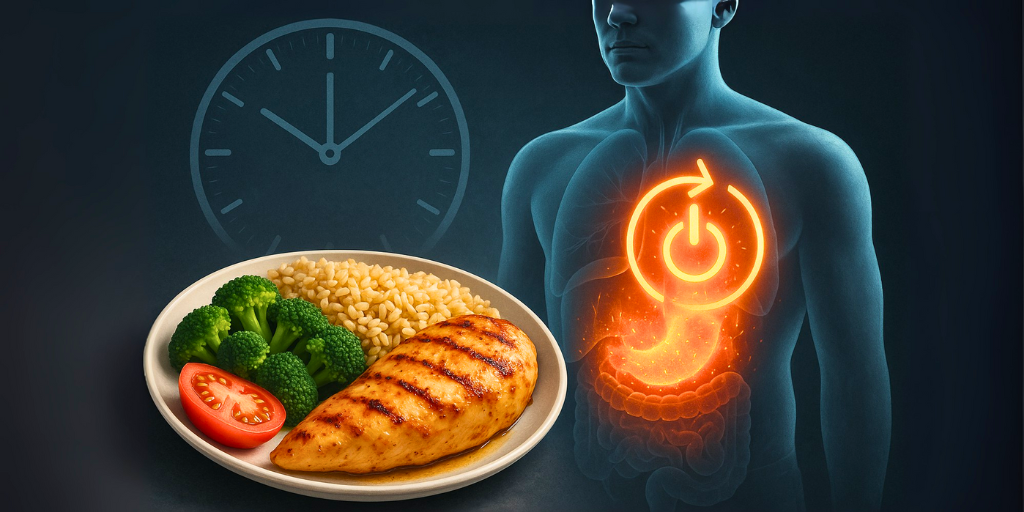
What if I told you that one of the most powerful ways to improve insulin resistance, activate fat burning, and retrain your metabolism didn’t involve cutting calories at all? It’s not the keto diet. It’s not even traditional fasting or caloric restriction. And it doesn’t require you to take a bunch of supplements or even change your exercise regimen. I call it metabolic micro-fasting. (Based on the insights of Thomas Delauer.)
This simple but profound strategy involves creating short, 6-to-8-hour gaps without food during your waking hours—not while you’re asleep. These are small, intentional breaks during your day that act as powerful metabolic resets, doing monumental things inside your body. The scientific literature is beginning to show that these metabolic micro-fasts flip crucial metabolic switches back and forth, creating lasting, positive changes in how your body uses energy. The problem is that our modern eating patterns—constant snacking and grazing—often leave these switches stuck in the “off” position. So, what exactly is a metabolic micro-fast, how do you do it, and how can it completely retrain your metabolism for the better? (Based on the insights of Thomas Delauer.)
Key Takeaways
- What They Are: Metabolic micro-fasts are intentional 6-to-8-hour periods of not eating during your active, waking day.
- The Goal: The primary purpose is not to reduce calories but to give your body a break from constant digestion, allowing your insulin levels to reset and improve your sensitivity to it.
- Metabolic Flexibility: These short fasts train your body to become more “metabolically flexible,” meaning it gets better at switching between burning carbohydrates and burning fat for fuel.
- The Problem with Grazing: Eating frequently, even healthy foods, keeps your insulin levels chronically elevated, which is a major driver of insulin resistance, weight gain, and metabolic dysfunction.
- The Mechanism: Micro-fasts activate a key metabolic regulator called AMPK, which signals your body to start burning stored fat and using glucose more efficiently.
- How to Start: You can begin by implementing two or three 6-to-8-hour micro-fasts per week, simply by skipping snacks between meals or delaying a meal.
1. What Exactly Is a Metabolic Micro-Fast?
First, let’s be clear about what this isn’t. This is not the same as a typical intermittent fasting schedule like 16:8, where you fast for 16 hours and eat within an 8-hour window. With those protocols, the majority of your fasting period happens while you’re asleep. While that’s certainly beneficial, you aren’t very metabolically active when you’re sleeping. You’re not moving around, thinking hard, or doing things that demand a lot of energy.
Metabolic micro-fasts are different because they capitalize on the time you are awake and active. Think of it as having breakfast and then simply skipping lunch to have an early dinner, or having an early breakfast and a late lunch. You create a 6-to-8-hour window without food during the day. What’s great about this approach is its flexibility. I experienced this inadvertently on a recent trip to Europe. I would work out in the morning, have a large, late breakfast, and then spend the day walking around, exploring the city with my family. Before I knew it, it would be 3:00 or 4:00 PM. At that point, eating lunch felt like it would just disrupt a good dinner. So, I’d just push through until dinner around 5:00 or 6:00 PM. I was able to enjoy a bigger breakfast and a bigger dinner, but I only ate two meals and had this powerful metabolic micro-fast in between. The result? I found it hard to keep weight on; I was getting leaner just by creating that space between meals, even while enjoying my food more.
2. The Problem with Constant Grazing: Your Insulin Needs a Break

Modern life has conditioned us to graze. We have a snack in the car, a few bites at our desk, a handful of nuts here, a piece of fruit there. This constant eating means constant insulin. Insulin is your primary storage hormone. When you eat, your body releases insulin to help your cells absorb glucose from your bloodstream for energy or storage. This is a normal, healthy process.
The problem arises when insulin is always present. Every time you eat—even one grape off your kid’s plate—you trigger an insulin bump. When these bumps happen all day long, your insulin level never has a chance to come back down to its baseline. Your cells are constantly being bombarded with insulin’s signal. Over time, they become desensitized, like someone who stops hearing a constant background noise. This is insulin resistance. Your body has to pump out even more insulin to get the same job done, creating a vicious cycle of high insulin and worsening resistance. This is more than just a weight loss issue; chronically high insulin is a hallmark of nearly every major chronic metabolic disease.
Metabolic micro-fasts interrupt this cycle. By creating a significant gap between meals, you allow your insulin levels to fall and stay low for a few hours. This break is not just about bringing insulin down; it’s about recalibration. It gives your cells a chance to “rest” and become sensitive to insulin’s signal again.
3. The Science Speaks: Why Meal Timing Can Trump Calories
For decades, we’ve been told that weight loss and metabolic health are all about calories in versus calories out. But a growing body of research shows that when you eat can be just as important as what you eat. A fascinating study published in the journal Cell Metabolism looked at this very idea. Researchers had participants follow a time-restricted feeding schedule, eating all their meals within a 6-hour window. Critically, their total daily calories were the same as the control group. The results were astounding. The time-restricted group showed significant reductions in insulin resistance, improved function of the insulin-producing beta cells in the pancreas, and even experienced weight loss. What’s more, they reported a decrease in appetite, likely because their insulin levels were no longer on a chaotic rollercoaster, allowing them to be more in tune with their natural hunger cues.
Another study highlighted what’s known as the “meal frequency effect.” It compared a group eating three square meals a day to a group eating six smaller meals, with both groups consuming the exact same number of calories and maintaining the same physical activity levels. The findings were clear: the six-meal-a-day group had chronically higher levels of both insulin and glucose throughout the day. This is precisely the state you want to avoid if you’re concerned about metabolic health. Unless you are in the top 10% of the population with perfect metabolic function, you should be paying close attention to avoiding chronically high circulating insulin. More meals, even if they are small and healthy, can mean more metabolic stress.
4. Unlocking Your Body’s “Fat-Burning Switch”: The Power of AMPK

So, what is the biological magic happening during these micro-fasts? It largely comes down to a powerful metabolic regulator in your body called AMP-activated protein kinase, or AMPK. Think of AMPK as your body’s master energy sensor. When your cells sense that energy levels are getting low—which happens when you go for a period without food—AMPK gets activated.
When AMPK is switched on, it sends out a cascade of signals that essentially tell your body it’s time to become more efficient and start using stored fuel. It increases fat oxidation (the burning of fat for energy), enhances glucose uptake by your cells (pulling sugar out of the blood), and reduces the buildup of fat within your cells. It’s the very same switch that gets flipped during exercise or longer periods of caloric restriction. A study in the Journal of Biological Chemistry confirmed that when cells experience glucose starvation, AMPK activity increases, triggering all these beneficial metabolic processes, independent of overall calorie intake.
The beauty of metabolic micro-fasts is that you get to activate AMPK and reap its benefits without having to commit to a long-term, difficult caloric deficit. You’re simply creating short, temporary energy deficits throughout your week to turn on this powerful fat-burning and health-promoting pathway.
5. How to Start with Metabolic Micro-Fasts: Your Actionable Plan
Putting this into practice is surprisingly simple. The goal is to incorporate two to three 6-to-8-hour metabolic micro-fasts into your week. You can add this to your existing routine, even if you already practice other forms of fasting on other days.
Here’s how you can do it:
- Option 1: Skip the Snacks. The easiest way to start is to simply cut out all snacks between your main meals. If you have breakfast at 8 AM and lunch at 1 PM, that’s only a 5-hour gap. Try pushing your lunch to 2 or 3 PM to create that 6-to-7-hour window.
- Option 2: Delay or Combine Meals. Have an early breakfast (e.g., 7 AM) and a late lunch (e.g., 2 PM), and then your normal dinner. Or, try the strategy I used in Europe: eat a larger, satisfying breakfast, skip lunch entirely, and then have a normal-to-large dinner in the evening. This creates a perfect 7-to-8-hour micro-fast right in the middle of your day.
Remember, the goal here is not to remove a meal’s worth of calories from your day. We are not talking about traditional intermittent fasting where you might skip breakfast and keep everything else the same. The idea is to eat roughly the same amount of food, but just shuffle the timing to create that valuable, insulin-resetting space between meals.
Conclusion
Your body is an incredibly adaptable machine, but it needs the right signals to function optimally. The modern habit of constant grazing sends a continuous “store energy” signal, leading to metabolic gridlock. Metabolic micro-fasts are your way of hitting the reset button. They are not a punishing diet but a flexible, powerful tool to restore insulin sensitivity, enhance fat burning, and build a more resilient metabolism. By teaching your body to expertly toggle between using carbs and fats for fuel, you move away from being a one-trick pony and become a master of your own metabolic health. Start with just two days a week, and you’ll be amazed at how much better you can feel by simply giving your body a well-deserved break.
Source: Thomas Delauer

